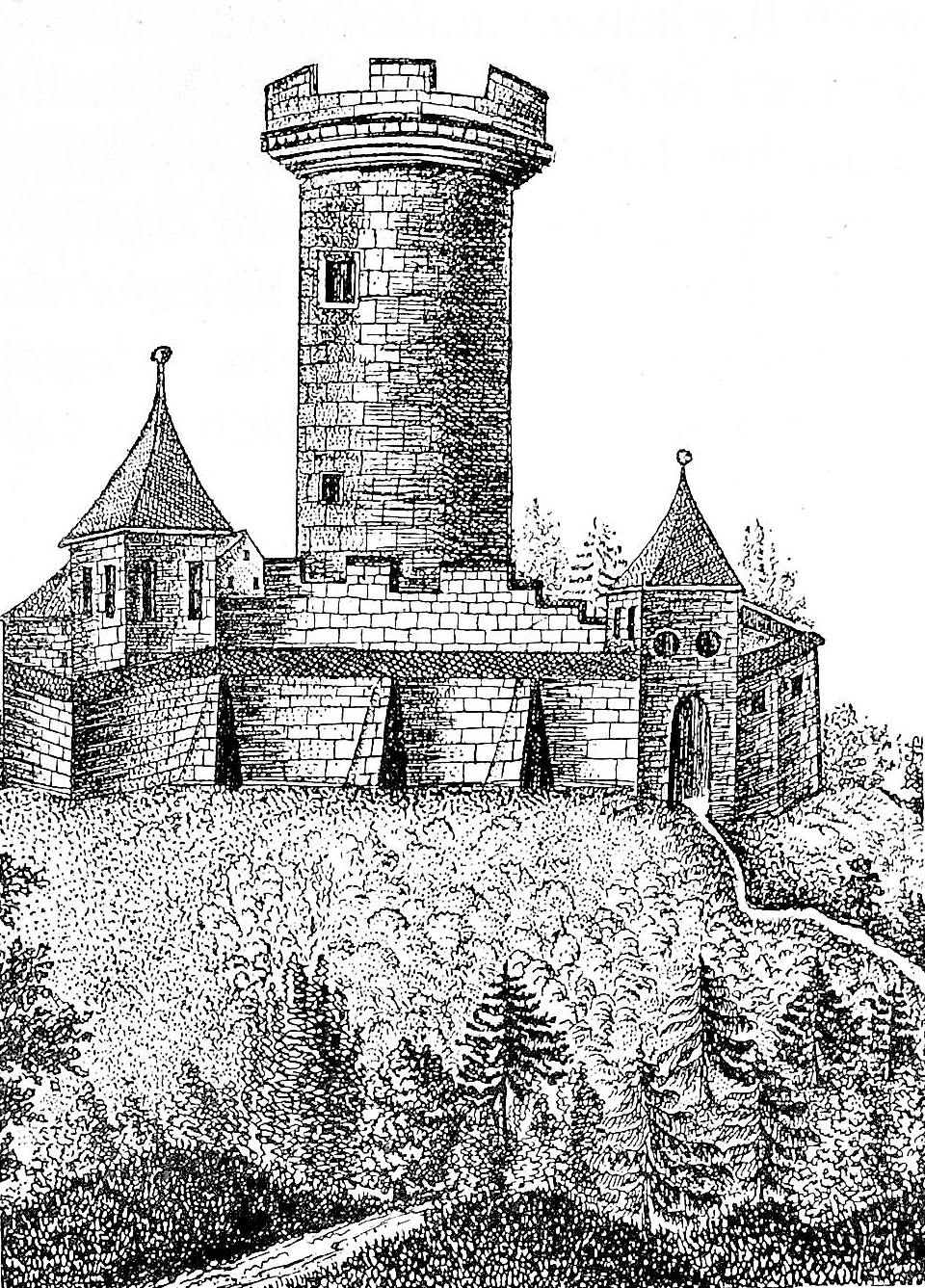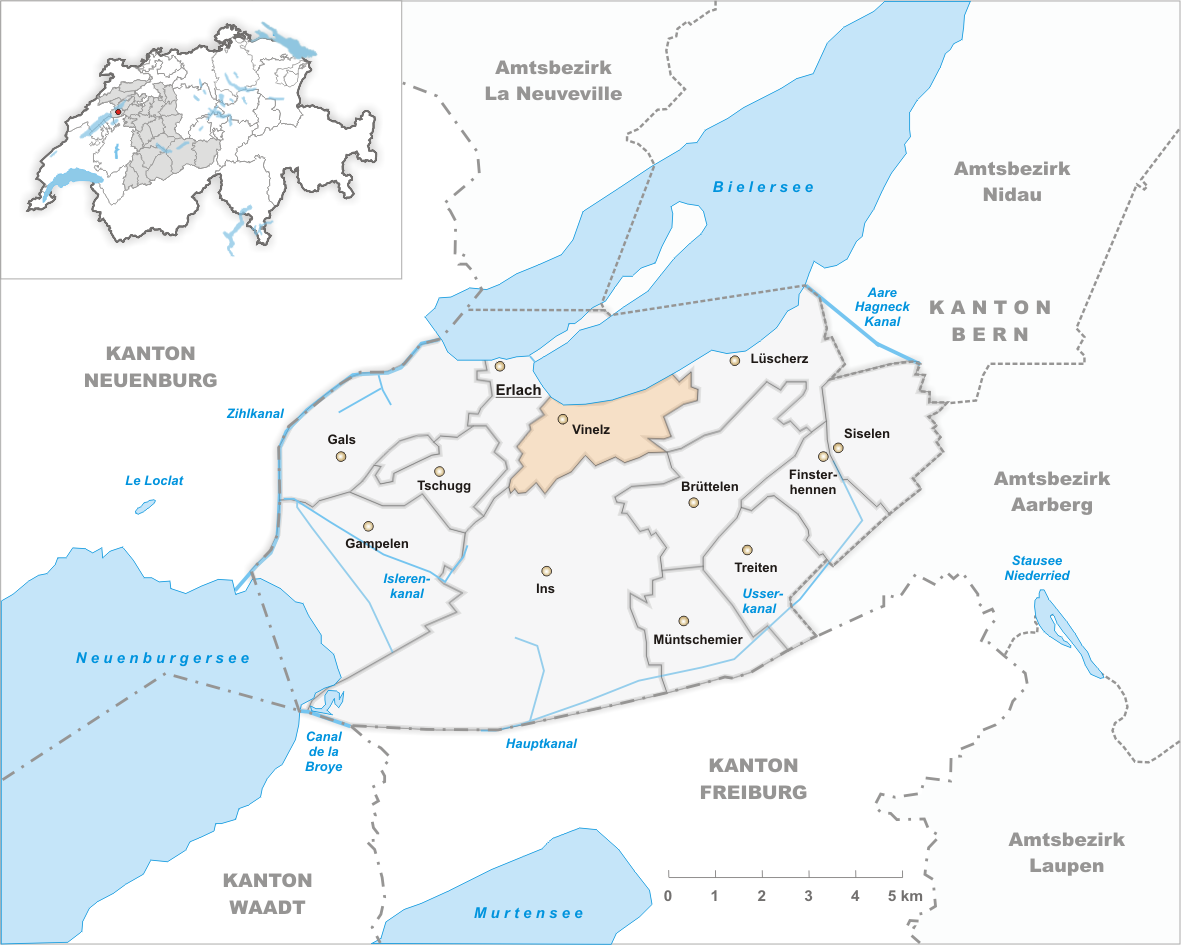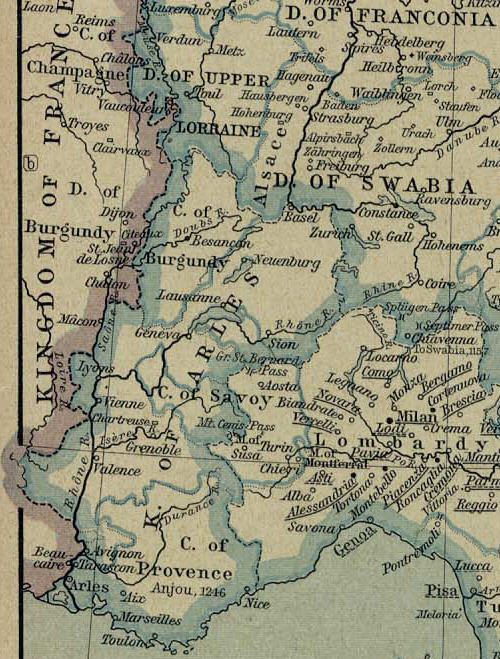|
Canton Of Neuchâtel
The Republic and Canton of Neuchâtel (french: République et Canton de Neuchâtel); rm, Chantun Neuchâtel; it, Cantone di Neuchâtel is a French-speaking canton in western Switzerland. In 2007, its population was 169,782, of whom 39,654 (or 23.4%) were foreigners. The capital is Neuchâtel. History The only part of present-day Switzerland to enter the Confederation as a principality (on May 19, 1815), Neuchâtel has a unique history. Its first recorded ruler, Rudolph III of Burgundy, mentioned Neuchâtel in his will in 1032. The dynasty of Ulrich count of Fenis (Hasenburg) took over the town and its territories in 1034. The dynasty prospered and, by 1373, all the lands now part of the canton belonged to the count. In 1405, the cities of Bern and Neuchâtel entered a union. The lands of Neuchâtel had passed to the Zähringen lords of Freiburg in the late 14th century as inheritance from the childless Elisabeth, Countess of Neuchâtel, to her nephews, and then in 1458 ... [...More Info...] [...Related Items...] OR: [Wikipedia] [Google] [Baidu] |
Cantons Of Switzerland
The 26 cantons of Switzerland (german: Kanton; french: canton ; it, cantone; Sursilvan and Surmiran: ; Vallader and Puter: ; Sutsilvan: ; Rumantsch Grischun: ) are the member states of the Swiss Confederation. The nucleus of the Swiss Confederacy in the form of the first three confederate allies used to be referred to as the . Two important periods in the development of the Old Swiss Confederacy are summarized by the terms ('Eight Cantons'; from 1353–1481) and ('Thirteen Cantons', from 1513–1798).rendered "the 'confederacy of eight'" and "the 'Thirteen-Canton Confederation'", respectively, in: Each canton of the Old Swiss Confederacy, formerly also ('lieu/locality', from before 1450), or ('estate', from ), was a fully sovereign state with its own border controls, army, and currency from at least the Treaty of Westphalia (1648) until the establishment of the Swiss federal state in 1848, with a brief period of centralised government during the Helvetic Republic ... [...More Info...] [...Related Items...] OR: [Wikipedia] [Google] [Baidu] |
Orléans-Longueville
Duke of Longueville (''Longueville-sur-Scie'') was a title of French nobility, though not a peerage of France. History The title was created in 1505 by King Louis XII of France for his first cousin once removed, François d'Orléans, Count of Dunois, son of François d'Orléans, Count of Dunois, son of Jean d'Orléans, himself an illegitimate son of the Duke of Orléans. The title became extinct in 1694, following the death of Jean Louis Charles d'Orléans, who was the brother of Marie de Nemours. From 1648, the Duke of Longueville was also Sovereign Prince of Neuchâtel, a Swiss territory. In 1654, the eighth duke was created a peer as Duke of Coulommiers, but the peerage was never registered and so became extinct at his death. Dukes of Longueville # François II (1478–1513). # Louis I (1480–1516), brother of the preceding. # Claude (1508–1524), son of the preceding. # Louis II (1510–1537), brother of the preceding. # François III (1535–1551), son of the prec ... [...More Info...] [...Related Items...] OR: [Wikipedia] [Google] [Baidu] |
Sausenburg
Sausenburg Castle is a ruined German castle on the edge of the Black Forest, just north of the town of Kandern in Baden-Württemberg, between the villages of Sitzenkirch and Malsburg-Marzell. The castle was originally the stronghold of the lords of Sausenburg, and is built on a hill, 665 metres high, known as the ''Sausenberg''. History At the beginning of the 12th century, the area was given to the Benedictine monks of the Monastery of St Blaise. The counts of Hachberg acquired the property in 1232 from the monastery. They built the castle in order to protect the area and lived there from 1246. In 1306, the counts founded the Sausenberg dynasty. From that point on, they called themselves the Margraves of Hachberg-Sausenberg. In 1315, Liuthold II of Roetteln, the last male member of his dynasty, bestowed Roetteln to the counts of Hachberg-Sausenberg. He died in 1316. The counts of Hachberg-Sausenberg moved to Rötteln Castle and established their advocates (''vogts'') on th ... [...More Info...] [...Related Items...] OR: [Wikipedia] [Google] [Baidu] |
Elisabeth, Countess Of Neuchâtel
Elisabeth, Countess of Neuchâtel or Isabelle de Neuchâtel (died 25 December 1395) was ruling countess de jure of the County of Neuchâtel from 1373 until 1395. She was the daughter of Louis I of Neuchâtel and Jeanne de Montfaucon and married Rodolphe IV de Nidau. References * Annales historiques du Comté de Neuchâtel et Valangin depuis Jules-César jusqu'en 1722, Jonas Boyve, édition E. Mathey, 1854, p. 365 à 397. Google livres {{Authority control 1395 deaths 14th-century women rulers Counts of Neuchâtel ... [...More Info...] [...Related Items...] OR: [Wikipedia] [Google] [Baidu] |
Freiburg Im Breisgau
Freiburg im Breisgau (; abbreviated as Freiburg i. Br. or Freiburg i. B.; Low Alemannic: ''Friburg im Brisgau''), commonly referred to as Freiburg, is an independent city in Baden-Württemberg, Germany. With a population of about 230,000 (as of 31 December 2018), Freiburg is the fourth-largest city in Baden-Württemberg after Stuttgart, Mannheim, and Karlsruhe. The population of the Freiburg metropolitan area was 656,753 in 2018. In the south-west of the country, it straddles the Dreisam river, at the foot of the Schlossberg. Historically, the city has acted as the hub of the Breisgau region on the western edge of the Black Forest in the Upper Rhine Plain. A famous old German university town, and archiepiscopal seat, Freiburg was incorporated in the early twelfth century and developed into a major commercial, intellectual, and ecclesiastical center of the upper Rhine region. The city is known for its medieval minster and Renaissance university, as well as for its high s ... [...More Info...] [...Related Items...] OR: [Wikipedia] [Google] [Baidu] |
House Of Zähringen
The House of Zähringen (german: Zähringer) was a dynasty of Swabian nobility. The family's name derived from Zähringen Castle near Freiburg im Breisgau. The Zähringer in the 12th century used the title of Duke of Zähringen, in compensation for having conceded the title of Duke of Swabia to the Staufer in 1098. The Zähringer were granted the special title of Rector of Burgundy in 1127, and they continued to use both titles until the extinction of the ducal line in 1218. The territories and fiefs held by the Zähringer were known as the 'Duchy of Zähringen' (), but it was not seen as a duchy in equal standing with the old stem duchies. The Zähringer attempted to expand their territories in Swabia and Burgundy into a fully recognized duchy, but their expansion was halted in the 1130s due to their feud with the Welfs. Pursuing their territorial ambitions, the Zähringer founded numerous cities and monasteries on either side of the Black Forest, as well as in the wester ... [...More Info...] [...Related Items...] OR: [Wikipedia] [Google] [Baidu] |
Bern
Bern () or Berne; in other Swiss languages, gsw, Bärn ; frp, Bèrna ; it, Berna ; rm, Berna is the ''de facto'' capital of Switzerland, referred to as the " federal city" (in german: Bundesstadt, link=no, french: ville fédérale, link=no, it, città federale, link=no, and rm, citad federala, link=no). According to the Swiss constitution, the Swiss Confederation intentionally has no "capital", but Bern has governmental institutions such as the Federal Assembly and Federal Council. However, the Federal Supreme Court is in Lausanne, the Federal Criminal Court is in Bellinzona and the Federal Administrative Court and the Federal Patent Court are in St. Gallen, exemplifying the federal nature of the Confederation. With a population of about 133,000 (as of 2022), Bern is the fifth-most populous city in Switzerland, behind Zurich, Geneva, Basel and Lausanne. The Bern agglomeration, which includes 36 municipalities, had a population of 406,900 in 2014. The metropolitan ... [...More Info...] [...Related Items...] OR: [Wikipedia] [Google] [Baidu] |
Vinelz
Vinelz is a municipality in the Seeland administrative district in the canton of Bern in Switzerland. History Vinelz is first mentioned in 1228 as ''Fenis''. The municipality was formerly known by its French name ''Fenil'', however, that name is no longer used. There were extensive Neolithic and Bronze Age settlements along the shore of Lake Biel, which stretch into Lüscherz. Inland an Early Bronze Age settlement has been discovered at Schattewil, while Roman settlements were found at Mieschzälg and Flachseren. During the Middle Ages it was part of the '' Herrschaft'' of Erlach. In 1474 all the Erlach lands, including Vinelz, were acquired by Bern. Under Bernese rule it became part of the new bailiwick of Erlach. In 1691, Emanuel Gaudard, a citizen of Bern, built the ''Landsitz'' (country manor house) Obere Budlei in the village. The village church of St. Mary's was first mentioned in 1228. It was probably founded by the Counts of Fenis, who ruled from the near ... [...More Info...] [...Related Items...] OR: [Wikipedia] [Google] [Baidu] |
Rudolph III Of Burgundy
Rudolph III (french: Rodolphe, german: Rudolf; – 6 September 1032), called the Idle or the Pious, was the king of Burgundy from 993 until his death. He was the last ruler of an independent Kingdom of Burgundy, and the last male member of the Burgundian group of the Elder House of Welf. Family Rudolph was the son and heir of King Conrad I of Burgundy (925–993). His mother Matilda (943–980), a member of the Frankish Carolingian dynasty, was the daughter of King Louis IV of France. Rudolph himself had three sisters: Gerberga, who married Duke Herman II of Swabia about 988, Bertha, married to Count Odo I of Blois and secondly to King Robert II of France in 996, and Gisela, who married the Ottonian duke Henry II of Bavaria and became the mother of Emperor Henry II. Reign Rudolph succeeded to the Burgundian throne upon his father's death on 19 October 993 and was crowned king in Lausanne. His reign was marked with turbulence when he made attempts to confiscate severa ... [...More Info...] [...Related Items...] OR: [Wikipedia] [Google] [Baidu] |
Capital (political)
A capital city or capital is the municipality holding primary status in a country, state, province, department, or other subnational entity, usually as its seat of the government. A capital is typically a city that physically encompasses the government's offices and meeting places; the status as capital is often designated by its law or constitution. In some jurisdictions, including several countries, different branches of government are in different settlements. In some cases, a distinction is made between the official (constitutional) capital and the seat of government, which is in another place. English-language news media often use the name of the capital city as an alternative name for the government of the country of which it is the capital, as a form of metonymy. For example, "relations between Washington and London" refer to " relations between the United States and the United Kingdom". Terminology and etymology The word ''capital'' derives from the Latin word ... [...More Info...] [...Related Items...] OR: [Wikipedia] [Google] [Baidu] |
Switzerland
; rm, citad federala, links=no). Swiss law does not designate a ''capital'' as such, but the federal parliament and government are installed in Bern, while other federal institutions, such as the federal courts, are in other cities (Bellinzona, Lausanne, Lucerne, Neuchâtel, St. Gallen a.o.). , coordinates = , largest_city = Zurich , official_languages = , englishmotto = "One for all, all for one" , religion_year = 2022 , religion_ref = , religion = , demonym = , german: link=no, Schweizer/Schweizerin, french: link=no, Suisse/Suissesse, it, svizzero/svizzera or , rm, Svizzer/Svizra , government_type = Federal assembly-independent directorial republic , leader_title1 = Federal Council , leader_name1 = , leader_title2 = , leader_name2 = Viktor Rossi , legislature = Federal Assembly , upper_house = Counci ... [...More Info...] [...Related Items...] OR: [Wikipedia] [Google] [Baidu] |
Blason Ducs Bourgogne (ancien)
Blason is a form of poetry. The term originally comes from the heraldic term "blazon" in French heraldry, which means either the codified description of a coat of arms or the coat of arms itself. The Dutch term is Blazoen, and in either Dutch or French, the term is often used to refer to the coat of arms of a chamber of rhetoric. History The term forms the root of the modern words "emblazon", which means to celebrate or adorn with heraldic markings, and "blazoner", one who emblazons. The terms "blason", "blasonner", "blasonneur" were used in 16th-century French literature by poets who, following Clément Marot in 1536, practised a genre of poems that praised a woman by singling out different parts of her body and finding appropriate metaphors to compare them with. It is still being used with that meaning in literature and especially in poetry. One famous example of such a celebratory poem, ironically rejecting each proposed stock metaphor, is William Shakespeare's Sonnet 130: :' ... [...More Info...] [...Related Items...] OR: [Wikipedia] [Google] [Baidu] |



_4029.jpg)





